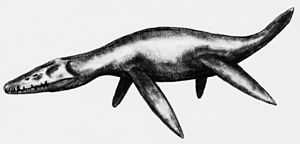Monster of Aramberri
| Monster of Aramberri Temporal range: Kimmeridgian (Upper Jurassic) | |
|---|---|
 | |
| Scientific classification | |
| Kingdom: | Animalia |
| Phylum: | Chordata |
| Subphylum: | Vertebrata |
| Class: | Sauropsida |
| Subclass: | Diapsida |
| Infraclass: | Lepidosauriomorpha |
| Order: | Plesiosauria |
| Superfamily: | Pliosauroidea |
The "monster of Aramberri" is the denomination that was given to the fossil remains of a huge marine reptile, a giant carnivore belonging to the Pliosauroidea clade that was found in Aramberri, Nuevo León, Mexico by a student of the Facultad de Ciencias de la Tierra of the Universidad Autónoma de Nuevo León while conducting geological mapping in 1985.[1]
Speculations
It was originally estimated that the remains belonged to a young individual which was more or less 15 meters long. It was initially falsely identified as Liopleurodon ferox;[2] this conclusion was used in BBC's Walking with Dinosaurs, in which the individual was the base to depict a very big Liopleurodon. French and German paleontologists classified it as a giant pliosaur, which lived around 140 millions years ago in shallow waters of the area, in what is now Aramberri, Mexico.
The specimen is not properly named and described yet though the first assumptions of it being a juvenile individual have been outdated and that it is apparently not related to Liopleurodon ferox. It remains possibly one of the largest pliosaur known, and perhaps the largest.[3]
Excavation and restoration
The director of excavation is Dr José Guadalupe López Oliva from the Facultad de Ciencias de la Tierra de la UANL. Other specialists involved are Dr. Wolfgang Stinnesbeck from the Faculty of Geosciences of Karlsruhe University, and Dr. Eberhard ("Dino") Frey and Dr. Marie Buchy of the Museum of Natural History of Karlsruhe, Germany.[4]
- Excavations:
- In 2001, the site was evaluated and dispersed remains were recovered. The stratum which contains pliosaur remains was identified.
- In 2002, a specific excavation began, supported by local people, to cleanse the sediment which contains bone remains of different sizes.
- Some remains were sent to the Museum of Natural History of Karlsruhe.
Monster of Aramberri in Germany
On January 3, 2003, remains of the Monster of Aramberri arrived in Karlsruhe, boxed in 14 huge containers. The Museum of Natural History the city of Karlsruhe was the place assigned for its reconstruction.
The bones would be prepared by the specialists of the Museum in order to copy them. Copies would stay at the Museum, while originals would return to Mexico.
Monster returns
As the Museum of Natural History of Karlsruhe could not accept any more remains because it was at its maximum capacity, new remains were sent to the Museo del Desierto in Saltillo, Coahuila, also in Mexico, where the specialist in marine reptiles, Dra. Marie Buchy, is still studying them.
Monster today
Nowadays, part of the fossil is on display at Museo de Historia Mexicana, in a temporary exposition called "Fósiles Marinos de Nuevo Léon, antes mar, ahora montañas".[5]
In November 2012, after 27 years from its discovery spent on expositions and research, the "Monster of Aramberri" remains were transferred to Facultad de Ciencias de la Tierra from UANL located at Linares, Nuevo León, México.[6]
References
- ↑ Buchy, Frey & al, 2003, First occurrence of a gigantic pliosaurid plesiosaur in the late Jurassic (Kimmeridgian) of Mexico, Bulletin de la Société Géologique de France, t. 174, n°3, pp. 271-278
- ↑ "El "monstruo of Aramberri"". BBC Mundo CIENCIA, Martes, 31 de diciembre del 2002. 7 June 2007.
- ↑ http://www.plesiosauria.com/news/index.php/mines-bigger-than-yours-the-monster-of-aramberri-predator-x-and-other-monster-pliosaurs-in-the-media/
- ↑ "El Monstruo de Aramberri: una recapitulación". Redesgeo.org, Red de Estudiantes de Geociencias. 7 June 2007.
- ↑ "Fosiles Marinos de Nuevo Léon". Museo de Historia Mexicana. 7 June 2007.
- ↑ "El 'Monstruo de Aramberri' regresa a casa". Milenio. Retrieved 22 November 2012.